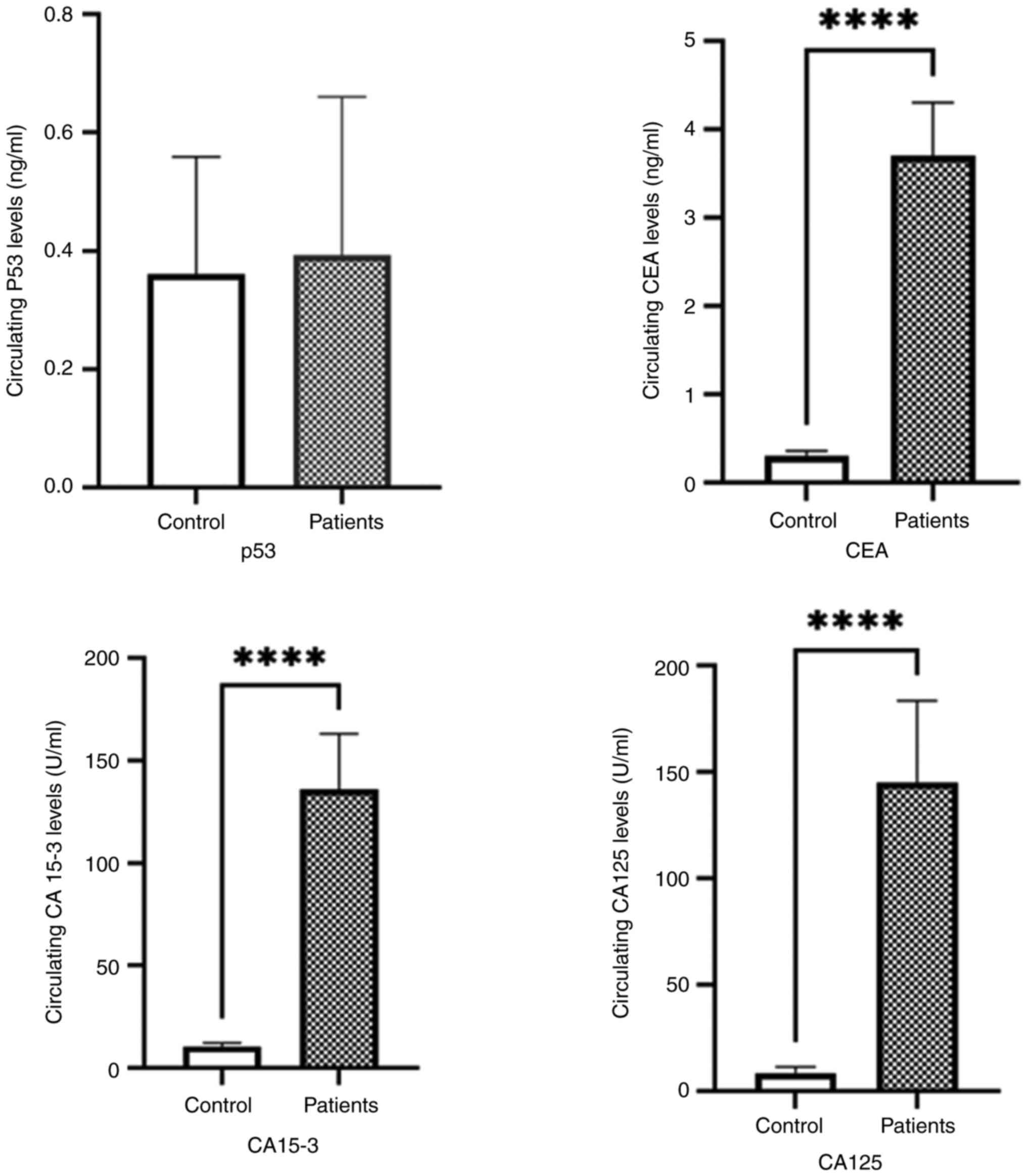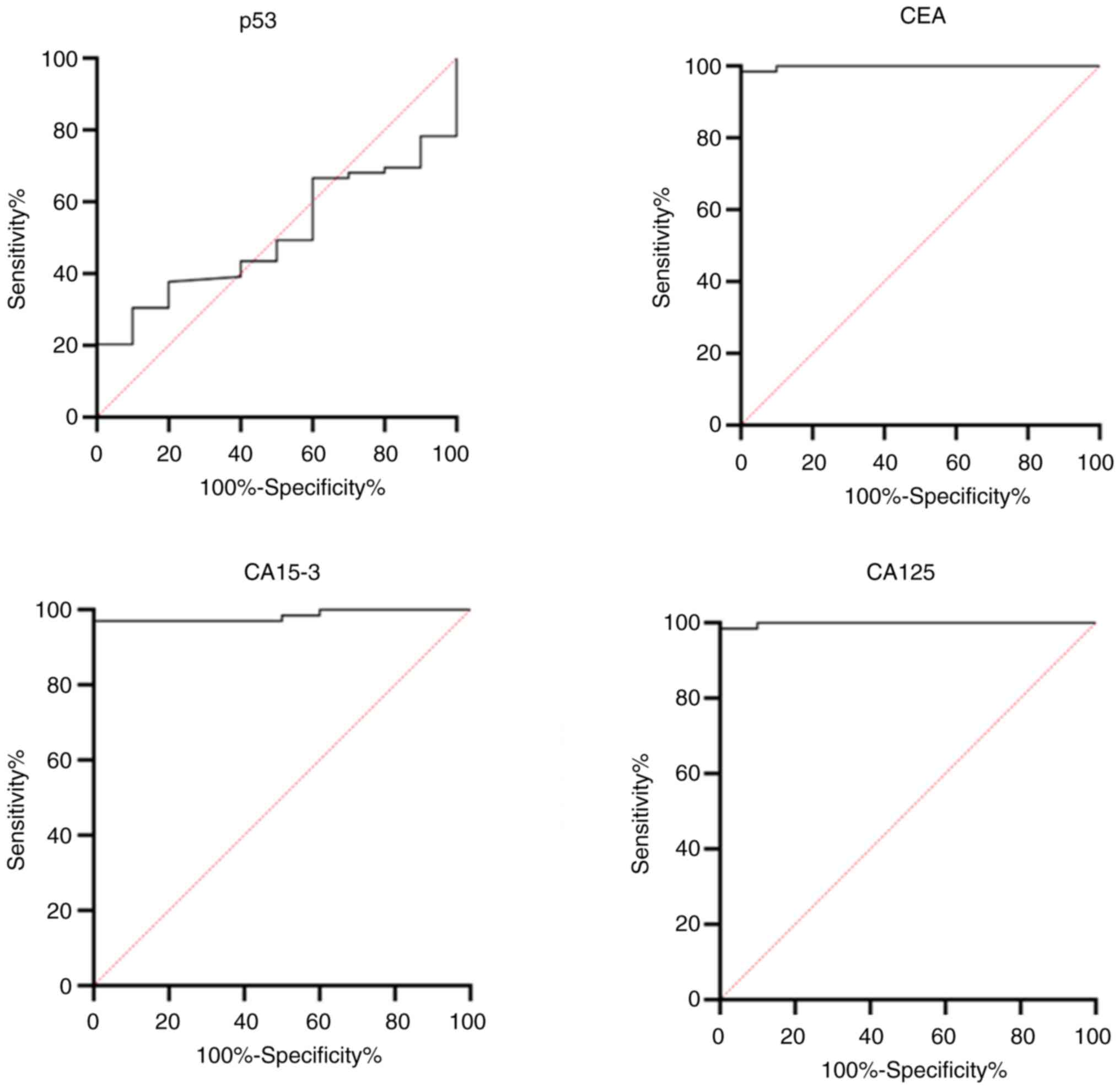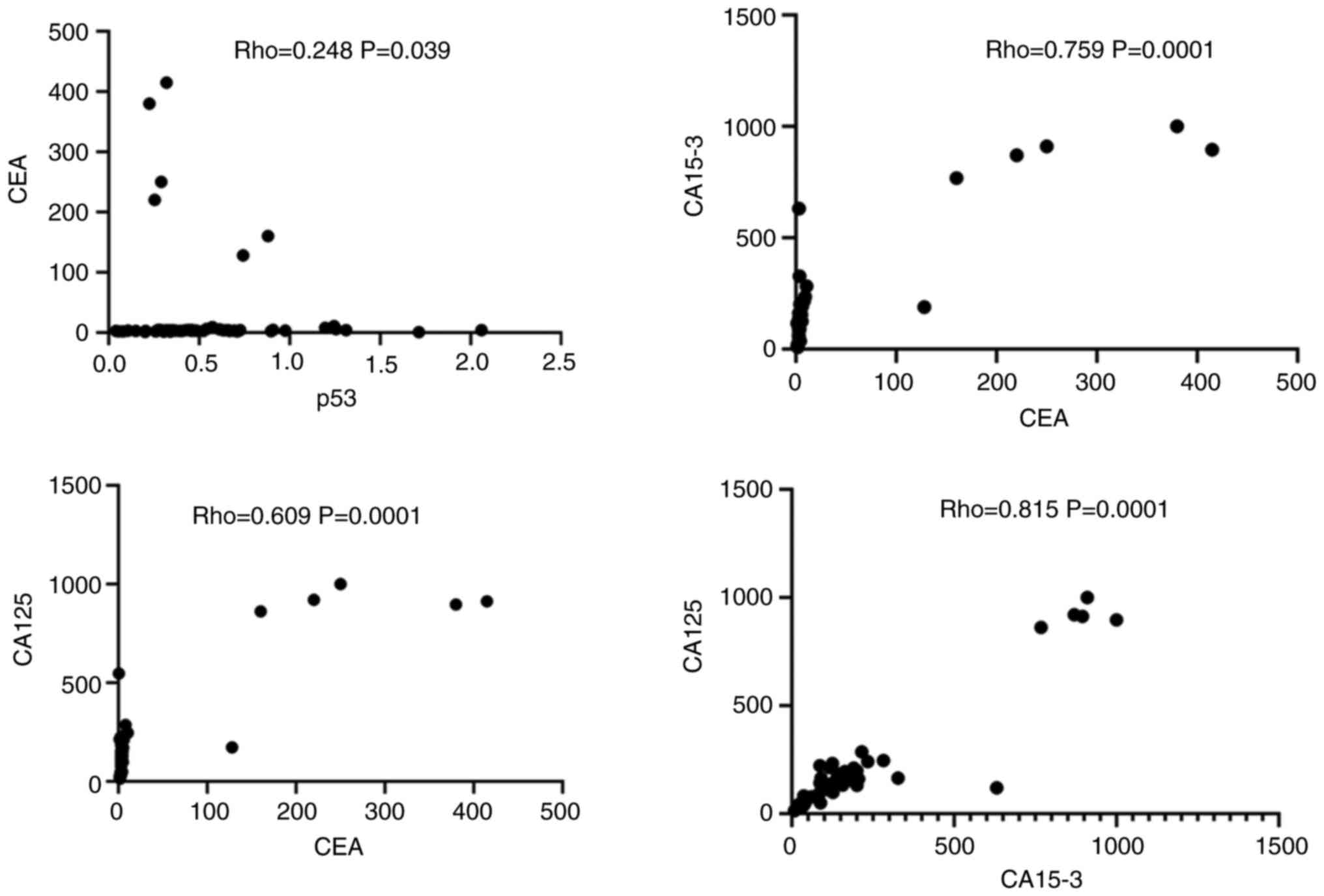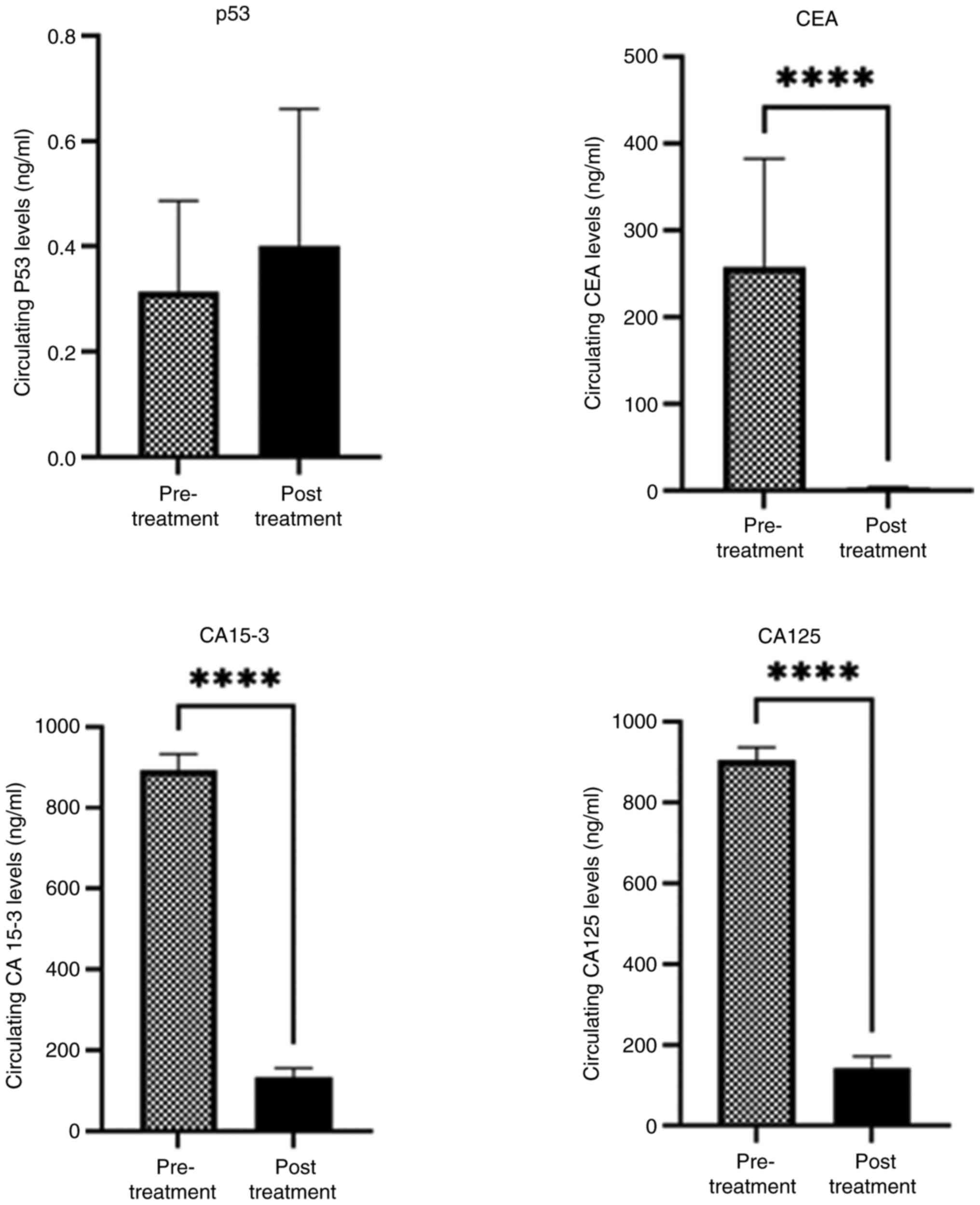|
1
|
Neves Rebello Alves L, Dummer Meira D,
Poppe Merigueti L, Correia Casotti M, do Prado Ventorim D, Ferreira
Figueiredo Almeida J, Pereira de Sousa V, Cindra Sant'Ana M,
Gonçalves Coutinho da Cruz R, Santos Louro L, et al: Biomarkers in
breast cancer: An old story with a new end. Genes (Basel).
14(1364)2023.PubMed/NCBI View Article : Google Scholar
|
|
2
|
Obeagu EI and Obeagu GU: Breast cancer: A
review of risk factors and diagnosis. Medicine (Baltimore).
103(e36905)2024.PubMed/NCBI View Article : Google Scholar
|
|
3
|
Lei S, Zheng R, Zhang S, Wang S, Chen R,
Sun K, Zeng H, Zhou J and Wei W: Global patterns of breast cancer
incidence and mortality: A population-based cancer registry data
analysis from 2000 to 2020. Cancer Commun (Lond). 41:1183–1194.
2021.PubMed/NCBI View Article : Google Scholar
|
|
4
|
Arnold M, Morgan E, Rumgay H, Mafra A,
Singh D, Laversanne M, Vignat J, Gralow JR, Cardoso F, Siesling S
and Soerjomataram I: Current and future burden of breast cancer:
Global statistics for 2020 and 2040. Breast. 66:15–23.
2022.PubMed/NCBI View Article : Google Scholar
|
|
5
|
Lv L, Zhao B, Kang J, Li S and Wu H: Trend
of disease burden and risk factors of breast cancer in developing
countries and territories, from 1990 to 2019: Results from the
global burden of disease study 2019. Front Public Health.
10(1078191)2023.PubMed/NCBI View Article : Google Scholar
|
|
6
|
Łukasiewicz S, Czeczelewski M, Forma A,
Baj J, Sitarz R and Stanisławek A: Breast cancer-epidemiology, risk
factors, classification, prognostic markers, and current treatment
strategies-an updated review. Cancers (Basel).
13(4287)2021.PubMed/NCBI View Article : Google Scholar
|
|
7
|
Azim HA, Elghazawy H, Ghazy RM, Abdelaziz
AH, Abdelsalam M, Elzorkany A and Kassem L: Clinicopathologic
features of breast cancer in Egypt-contemporary profile and future
needs: A systematic review and meta-analysis. JCO Glob Oncol.
9(e2200387)2023.PubMed/NCBI View Article : Google Scholar
|
|
8
|
Rakha EA, Tse GM and Quinn CM: An update
on the pathological classification of breast cancer.
Histopathology. 82:5–16. 2023.PubMed/NCBI View Article : Google Scholar
|
|
9
|
Rakha E, Toss M and Quinn C: Specific cell
differentiation in breast cancer: A basis for histological
classification. J Clin Pathol. 75:76–84. 2022.PubMed/NCBI View Article : Google Scholar
|
|
10
|
Sun YS, Zhao Z, Yang ZN, Xu F, Lu HJ, Zhu
ZY, Shi W, Jiang J, Yao PP and Zhu HP: Risk factors and preventions
of breast cancer. Int J Biol Sci. 13:1387–1397. 2017.PubMed/NCBI View Article : Google Scholar
|
|
11
|
Liu H, Shi S, Gao J, Guo J, Li M and Wang
L: Analysis of risk factors associated with breast cancer in women:
A systematic review and meta-analysis. Transl Cancer Res.
11:1344–1353. 2022.PubMed/NCBI View Article : Google Scholar
|
|
12
|
Wu HJ and Chu PY: Recent discoveries of
macromolecule- and cell-based biomarkers and therapeutic
implications in breast cancer. Int J Mol Sci.
22(636)2021.PubMed/NCBI View Article : Google Scholar
|
|
13
|
Das S, Dey MK, Devireddy R and Gartia MR:
Biomarkers in cancer detection, diagnosis, and prognosis. Sensors
(Basel). 24(37)2023.PubMed/NCBI View Article : Google Scholar
|
|
14
|
Marvalim C, Datta A and Lee SC: Role of
p53 in breast cancer progression: An insight into p53 targeted
therapy. Theranostics. 13:1421–1442. 2023.PubMed/NCBI View Article : Google Scholar
|
|
15
|
Duffy MJ, Synnott NC and Crown J: Mutant
p53 in breast cancer: Potential as a therapeutic target and
biomarker. Breast Cancer Res Treat. 170:213–219. 2018.PubMed/NCBI View Article : Google Scholar
|
|
16
|
Gupta A, Patil BU and Gangane NM: Role of
p53 and Her2/Neu as a prognostic biomarker in breast carcinoma. Med
J Dr DY Patil Univ. 16:191–196. 2023.
|
|
17
|
Duffy MJ, Walsh S, McDermott EW and Crown
J: Chapter one-biomarkers in breast cancer: Where are we and where
are we going? In: Advances in Clinical Chemistry. Makowski GS (ed).
Vol 71. Elsevier, Amsterdam, pp1-23, 2015.
|
|
18
|
Li H, Wang S, Li X, Cheng C, Shen X and
Wang T: Dual-channel detection of breast cancer biomarkers CA15-3
and CEA in human serum using dialysis-silicon nanowire field effect
transistor. Int J Nanomedicine. 17:6289–6299. 2022.PubMed/NCBI View Article : Google Scholar
|
|
19
|
Fang C, Cao Y, Liu X, Zeng XT and Li Y:
Serum CA125 is a predictive marker for breast cancer outcomes and
correlates with molecular subtypes. Oncotarget. 8:63963–63970.
2017.PubMed/NCBI View Article : Google Scholar
|
|
20
|
Afzal S, Hassan M, Ullah S, Abbas H,
Tawakkal F and Khan MA: Breast cancer; discovery of novel
diagnostic biomarkers, drug resistance, and therapeutic
implications. Front Mol Biosci. 9(783450)2022.PubMed/NCBI View Article : Google Scholar
|
|
21
|
Zhang J, Wei Q, Dong D and Ren L: The role
of TPS, CA125, CA15-3 and CEA in prediction of distant metastasis
of breast cancer. Clin Chim Acta. 523:19–25. 2021.PubMed/NCBI View Article : Google Scholar
|
|
22
|
Bader El Din NG, El-Shenawy R, Moustafa
RI, Khairy A and Farouk S: Association between the expression level
of miRNA-374a and TGF-β1 in patients with colorectal cancer. World
Acad Sci J. 6(68)2024.
|
|
23
|
Taneja P, Maglic D, Kai F, Zhu S, Kendig
RD, Fry EA and Inoue K: Classical and novel prognostic markers for
breast cancer and their clinical significance. Clin Med Insights
Oncol. 4:15–34. 2010.PubMed/NCBI View Article : Google Scholar
|
|
24
|
Ashour Byomy LG, Zahraan F, Aref M and
Ibrahim Mosa MF: Assessment of CEA and CA15-3 as potential
prognostic markers for breast cancer in Egyptian females. Alfarama
J Basic Appl Sci. 2:44–50. 2021.
|
|
25
|
Zhao W, Li X, Wang W, Chen B, Wang L,
Zhang N, Wang Z and Yang Q: Association of preoperative serum
levels of CEA and CA15-3 with molecular subtypes of breast cancer.
Dis Markers. 2021(5529106)2021.PubMed/NCBI View Article : Google Scholar
|
|
26
|
Gaughran G, Aggarwal N, Shadbolt B and
Stuart-Harris R: The utility of the tumor markers CA15.3, CEA,
CA-125 and CA19.9 in metastatic breast cancer. Breast Cancer Manag.
9(BMT50)2020.
|
|
27
|
Shao Y, Sun X, He Y, Liu C and Liu H:
Elevated levels of serum tumor markers CEA and CA15-3 are
prognostic parameters for different molecular subtypes of breast
cancer. PLoS One. 10(e0133830)2015.PubMed/NCBI View Article : Google Scholar
|
|
28
|
Hasan D: Diagnostic impact of CEA and CA
15-3 on chemotherapy monitoring of breast cancer patients. J Circ
Biomark. 11:57–63. 2022.PubMed/NCBI View Article : Google Scholar
|
|
29
|
Firouzabadi D, Rezvani A, Dehghanian A and
Mahmoudi L: Association of ki67 and tumor marker p53 in locally
advanced breast cancer patients and evaluation of response to
neoadjuvant chemotherapy: A survey in South Iran. Cancer Manag Res.
11:6489–6497. 2019.PubMed/NCBI View Article : Google Scholar
|
|
30
|
El-Moneim Ebied SA, El-Moneim NAA, Hewala
Tl, Anwar MM and Rabi SM: The diagnostic, prognostic and follow-up
value of serum Bcl-2, Bax and p53 proteins in breast cancer
patients: A comparison with serum CA 15-3. Middle East J Cancer.
4:51–62. 2013.
|
|
31
|
Tang J, Yan B, Li GF, Li QY, Liu WF, Liang
RB, Ge QM and Shao Y: Carbohydrate antigen 125, carbohydrate
antigen 15-3 and low-density lipoprotein as risk factors for
intraocular metastases in postmenopausal breast cancer. Medicine
(Baltimore). 100(e27693)2021.PubMed/NCBI View Article : Google Scholar
|
|
32
|
Uygur MM and Gümüş M: The utility of serum
tumor markers CEA and CA 15-3 for breast cancer prognosis and their
association with clinicopathological parameters. Cancer Treat Res
Commun. 28(100402)2021.PubMed/NCBI View Article : Google Scholar
|
|
33
|
Rahemi Z, Javadi A, Kazeminejad B,
Ebrahimi A, Vosough H, Taghavi A and Dabiri S: Diagnostic utility
of combined CEA, CA15-3 and CA125 biomarkers and cytomorphology in
suspicious and malignant serosal fluid. Iran J Pathol. 16:248–255.
2021.PubMed/NCBI View Article : Google Scholar
|
|
34
|
Khushk M, Khan A, Rehman A, Sheraz S,
Tunio YM, Rehman K, Rehman D, Ahmed M, Abbas K and Khan ME: The
role of tumor markers: Carcinoembryonic antigen and cancer antigen
15-3 in patients with breast cancer. Cureus.
13(e16298)2021.PubMed/NCBI View Article : Google Scholar
|
|
35
|
Khadhum HS, Ameen AA and Mm T: Assessment
of CA 15-3 and P53 biomarkers in diagnosis of breast cancer. BNIHS.
40:1343–4292. 2022.
|
|
36
|
Li J, Liu L, Feng Z, Wang X, Huang Y, Dai
H, Zhang L, Song F, Wang D, Zhang P, et al: Tumor markers CA15-3,
CA125, CEA and breast cancer survival by molecular subtype: A
cohort study. Breast Cancer. 27:621–630. 2020.PubMed/NCBI View Article : Google Scholar
|
|
37
|
Bae SY, Lee JH, Bae JW and Jung SP:
Differences in prognosis by p53 expression after neoadjuvant
chemotherapy in triple-negative breast cancer. Ann Surg Treat Res.
98:291–298. 2020.PubMed/NCBI View Article : Google Scholar
|
|
38
|
Lee HC, Ko H, Seol H, Noh DY, Han W, Kim
TY, Im SA and Park IA: Expression of immunohistochemical markers
before and after neoadjuvant chemotherapy in breast carcinoma, and
their use as predictors of response. J Breast Cancer. 16:395–403.
2013.PubMed/NCBI View Article : Google Scholar
|
|
39
|
Varna M, Bousquet G, Plassa LF, Bertheau P
and Janin A: TP53 status and response to treatment in breast
cancers. J Biomed Biotechnol. 2011(284584)2011.PubMed/NCBI View Article : Google Scholar
|
|
40
|
Anoop TM, Joseph PR, Soman S, Chacko S and
Mathew M: Significance of serum carcinoembryonic antigen in
metastatic breast cancer patients: A prospective study. World J
Clin Oncol. 13:529–539. 2022.PubMed/NCBI View Article : Google Scholar
|
|
41
|
Varzaru VB, Eftenoiu AE, Vlad DC, Vlad CS,
Moatar AE, Popescu R and Cobec IM: The influence of tumor-specific
markers in breast cancer on other blood parameters. Life (Basel).
14(458)2024.PubMed/NCBI View Article : Google Scholar
|













